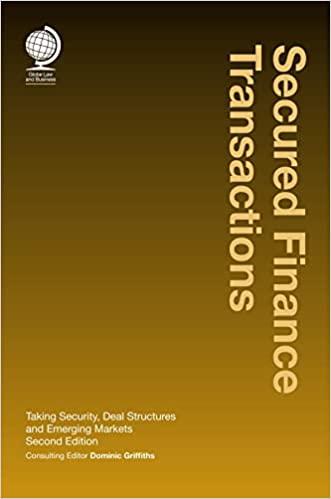Question
Income Statement At year-end, King Power Company achieved $6 million in revenue (EBITDA). Depreciation expense was $1.2 million, interest paid was $800,000 and the corporate
Income Statement
At year-end, King Power Company achieved $6 million in revenue (EBITDA). Depreciation expense was $1.2 million, interest paid was $800,000 and the corporate tax rate was 35%. At the end of the fiscal year, the company had current assets totaling $12 million, $4 million in accounts payable, $1.5 million in accumulated debt, $1.3 million in other debts payable and $8 million in property, plant and equipment. Suppose King Power has no excess cash, uses debt and equity to fund its operations, has no current liabilities, and recognizes depreciation periodically.
1. Determine the net income or loss of the company. Explain how this result can help the manager in making decisions in the company.
2. Calculate net and operating working capital. Explain the difference between the two results.
3. If the company had $6 million in property, plant and equipment the previous year and net working capital remained constant, what is the company's available cash flow? It explains how the result of the available flow helps managers in the financial planning process.
Part 2
Balance Sheet
River & Stone Corp.'s assets include current assets, property, plant and equipment and does not have excess cash (Free Cash). It has assets valued at $4 million and its fixed assets are valued at $3 million. It reports debts payable of $350,000, long-term debts of $650,000 and stockholders' equity of $2 million. Your status reflects that you have accounts payable and accumulated debts. Generally, the company operates on a debt and stockholders' equity basis.
1. Determine the total amount of the company's debt.
2. Calculate the balance of current assets and liabilities.
3. Determine the net working capital of the company.
4. Calculate net operating working capital.
5. Explain how net working capital and operating working capital can support management decisions and strategic goals.
Part 3
Financial Statements, Cash Flow and Taxes
Kairos Industries' year-end 2018 and 2019 balance sheets are shown below:
| 2019 | 2018 | |
| Cash | $102,950 | $89,825 |
| Accounts receivable | 103,465 | 85,627 |
| Inventories | 38, 544 | 35,082 |
| Total current assets | 244, 959 | 210, 534 |
| Property, plant and equipment | 67,265 | 42,536 |
| Total assets | 312,224 | 253,070 |
| Accounts payable | 30,861 | 23,209 |
| Accumulations | 30,577 | 22,756 |
| Obligations payable | 16,817 | 14,317 |
| Total current liabilities | 78,255 | 60,282 |
| Long-term debts | 76,364 | 64,014 |
| Total liabilities | 154, 619 | 124,296 |
| Joint actions | 100,000 | 90,100 |
| Retained earnings | 57,605 | 38,874 |
| Total stockholders' equity | 157,605 | 128,974 |
| Total liabilities plus capital | $312,224 | $253,270 |
1. In 2019, Kairos Industries achieved sales of $330 million and EBITDA of 17% of sales. Depreciation as amortization of fixed assets was 11% and interest paid was $2 million. Moreover, the tax rate was 35% and 38% of net income is allocated to dividends. Prepare an income statement taking into consideration the data presented.
2.Prepares the capital statement for the period ending December 31, 2019.
3. Taking into consideration that Kairos Industries does not have surplus cash on hand, it determines Free Cash Flow and working capital.
4. Explain the effect it would have on the taxes paid by shareholders and the company if Kairos Industries increased the dividend rate it pays.
5. Calculate economic value added (EVA) and market value added (MVA) in 2019, considering that the cost of capital after tax is 12% and Kairos Industries' stock price is $20 with 9 million shares outstanding.
Step by Step Solution
There are 3 Steps involved in it
Step: 1

Get Instant Access to Expert-Tailored Solutions
See step-by-step solutions with expert insights and AI powered tools for academic success
Step: 2

Step: 3

Ace Your Homework with AI
Get the answers you need in no time with our AI-driven, step-by-step assistance
Get Started


